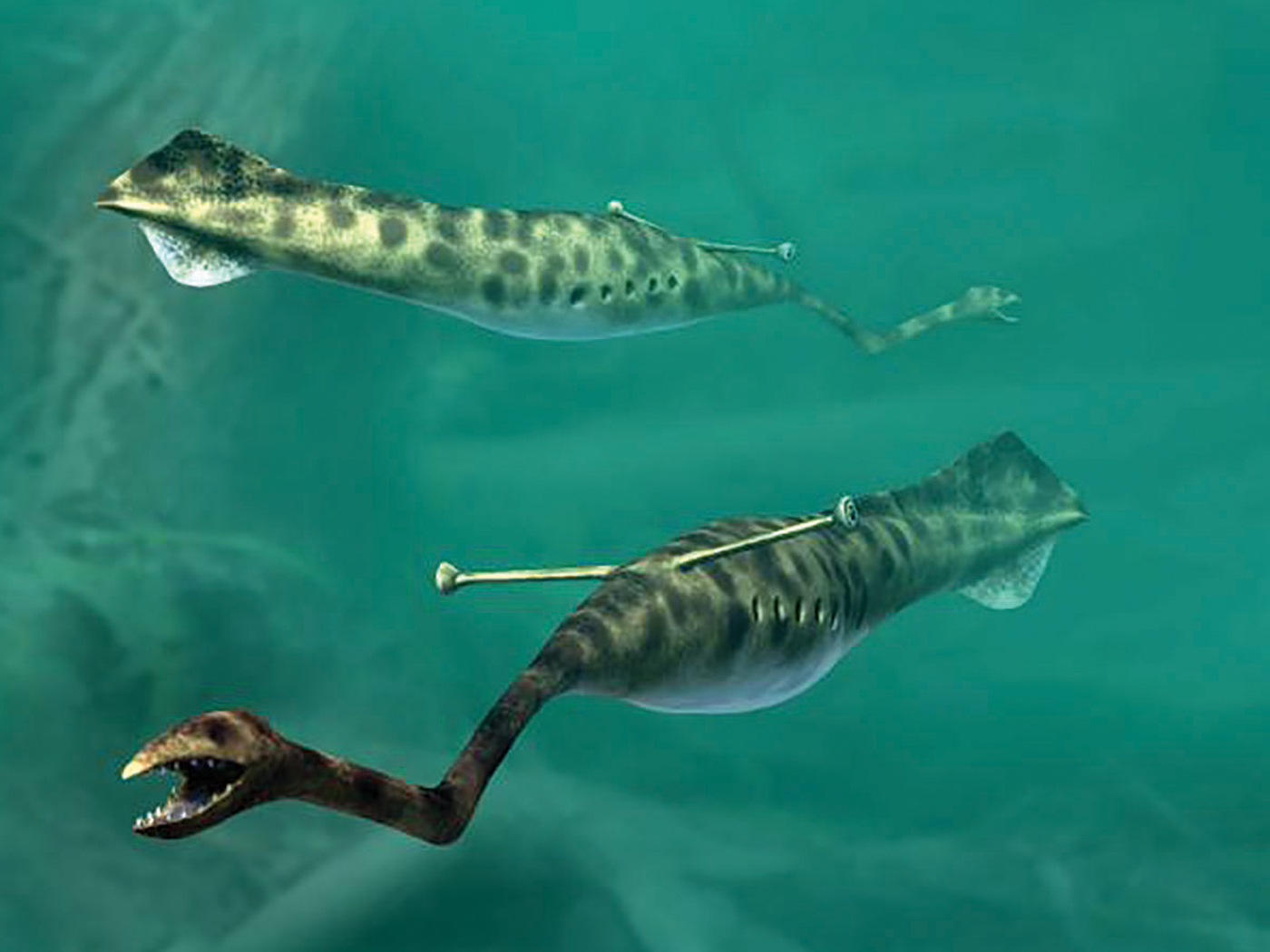Paleontologists have discovered portions of a giant ichthyosaur’s lower jawbone on Blue Anchor Beach at the southern entrance to the United Kingdom’s Bristol Channel.1,2 Although ichthyosaurs have a superficial resemblance to dolphins, which are mammals, they are actually reptiles. A similar ichthyosaur jawbone was discovered nearby at Lilstock in 2018. Long bones, originally thought to belong to dinosaurs, discovered near Aust Cliff at the northeastern end of Bristol Channel are also thought to possibly have belonged to giant ichthyosaurs. Details of the two jawbone discoveries can be freely read online, as well as a preprint of the paper describing the original discovery of the long bones near Aust Cliff.2,3,4
Scientists estimate the total length of the Blue Anchor Beach jawbone to be more than two meters (6.6 feet) long. Based on comparisons with other giant ichthyosaurs, they think this particular ichthyosaur could have been 25 meters (82 feet) long, about the length of a blue whale, the largest mammal ever known. If so, that would make this ichthyosaur the largest marine reptile fossil ever discovered.
The paper’s authors believe the fossil evidence is now sufficiently strong to assign this giant ichthyosaur a new genus and species name, Ichthyotitan severnensis (“giant fish lizard of the Severn”). The species name severnensis refers to the fact that the Severnensis River flows into Bristol Channel, where both jawbone fossils were discovered. Another giant ichthyosaur, belonging to the genus Shonisaurus, is shown in the above figure.
Paleontologists have known for quite some time that giant, 19- to 65-foot-long ichthyosaurs existed.3 By evolutionary reckoning, these giants lived during the Triassic Period, about 200 million years ago. Creationists think these were creatures living in the pre-Flood world that were killed and buried during the Flood of Noah just 4,300 years ago. Interestingly, the authors said that the stratigraphic horizon just above the Lilstock and Blue Anchor Rock jawbones contained “extensive seismite and tsunamite rocks,...indicative of the Late Triassic global mass extinction event.” Although creationists disagree with this interpretation, this mention of rocks associated with tsunamis and seismic events is of interest, as a paper presented at last year’s International Conference on Creationism used sophisticated computer modeling to demonstrate that giant earthquake-generated tsunamis during the Flood can plausibly account for the thick sedimentary rock layers on the continents.5
Aside from the rocks it was buried in, the amazing size of this fossil animal should be of interest to Bible-believing Christians because it may support the findings of creation science research studies that have shown that both larger adult body sizes and prolonged (or delayed) maturation are often associated with greater longevity in living animals.6 These ichthyosaurs were obviously very large. Moreover, based on subtle details of the bone microstructure in these ichthyosaur bones, paleontologists think they were still growing when they died.1,2,3 That they may have been still growing even after achieving such large sizes might be evidence of prolonged or delayed maturation. However, it’s not possible to be sure, since we simply don’t know how long it had already grown prior to death.
In any case, ICR research is showing evidence that at least some pre-Flood animals were living longer than their modern-day descendants,7 and the Genesis Flood makes the most sense of why their fossil remains are found in water-deposited rocks all over the world.
References
- Paleontologists unearth what may be the largest known marine reptile. ScienceDaily. Posted on sciencedaily.com April 17, 2024, accessed April 18, 2024.
- Lomax, D. R. et al. 2024. The last giants: New evidence for giant Late Triassic (Rhaetian) ichthyosaurs from the UK. PLoS ONE. 19 (4): e0300289.
- Lomax, D. R. et al. 2018. A giant Late Triassic ichthyosaur from the UK and a reinterpretation of the Aust Cliff ‘dinosaurian’ bones. PLoS ONE. 13 (4): e0194742.
- Redelstorff, R. et al. 2014. Unique bone histology in partial large bone shafts from Upper Triassic of Aust Cliff, England: An early independent experiment in gigantism. Acta Palaeontologica Polonica. 59 (3): 607–615.
- Baumgardner, J. and E. Navarro. 2023. The role of large tsunamis in the formation of the Flood sediment record. Proceedings of the International Conference on Creationism. 9, article 13.
- Hebert, J. 2023. ICR Research is Revealing Evidence for Pre-Flood Longevity. Creation Science Update. Posted on ICR.org October 30, 2023, accessed April 19, 2024.
- Hebert, J., R. Overman, and F. J. Sherwin. 2024. Crassostrea oyster fossils show evidence of extreme longevity. Creation Research Society Quarterly. 60 (3): 171–190.
* Dr. Jake Hebert is a research associate at the Institute for Creation Research and earned his Ph.D. in physics from the University of Texas at Dallas.







